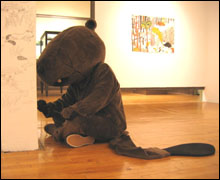 I’d been looking forward to Shintaro Miyake’s Beaver No Seikatsu (“Life of Beaver”) for weeks. For his first major show in the US, the 35-year-old Tokyo artist would create a pond filled with real water, a dam, beaver lodges, and drawings of beavers and kayakers. He’d present a beaver mockumentary. And for the first three days, he’d don a plush beaver get-up and draw on the walls. What could be cooler?
I’d been looking forward to Shintaro Miyake’s Beaver No Seikatsu (“Life of Beaver”) for weeks. For his first major show in the US, the 35-year-old Tokyo artist would create a pond filled with real water, a dam, beaver lodges, and drawings of beavers and kayakers. He’d present a beaver mockumentary. And for the first three days, he’d don a plush beaver get-up and draw on the walls. What could be cooler?
When I arrived at MassArt for the opening on February 7, the place was packed with art-student hipsters, some faculty, a cute short-haired girl wearing an “I ♥ beavers” T-shirt, a few Newbury Street nabobs, and a handful of parents and kids. The artist appeared in beaver garb and proceeded to scribble more beavers and kayakers on the support columns of the gallery as people crowded in to see. It was the kind of crowd where you unconsciously scan for exits. Clearly I was in the right place.
Miyake is the sort of artist who obsessively doodles cartoony girls on razor scooters, Star Wars heroes, pink Godzillas, bikini babes surfing atop jellyfish. His signature shtick is sketching on gallery walls or wandering the streets dressed as a plush rabbit, a round space alien, a kabuki actor, or a smiling pink-skinned blonde. In Italy, he jogged around the Colosseum dressed as a Minotaur and then “fought” a giant squid that bled helium-filled balloons.
He works in the international style a pal of mine has dubbed “Cute Brut.” Cute Brut adopts cute pop looks but cuts that cuteness with adult concerns and folkie or Art Brut techniques. The cuteness is a critique of traditional gender roles (i.e., real men don’t do cute), but these artists take it for granted that cartooning is a language that can take on any subject. Recent specimens around the city have included Brooklyn artist Misaki Kawai’s clunky paintings at Allston Skirt Gallery, the Paper Rad gang from East Hampton at Second Gallery (through March 10), and Boston artist Misa Saburi’s little wooden effigies at the Boston Center for the Arts (through March 19).
When I returned to MassArt a couple of days later, I found Beaver (Miyake in costume) still doodling on the gallery’s columns and a steady stream of people wandering in and out. One room had a pond filled with real water and stuffed beaver dolls perched on lodges. In a second room, a souvenir stand offered beaver trinkets, and an alcove featured actual beaver skeletons and pelts borrowed from Harvard. On the walls hung Miyake’s pencil and watercolor drawings of giant beavers gnawing bare trees and cavorting around lodges in ponds divided by dams made of upright sticks. Miniature houses appeared in the drawings, alone or clustered in dense villages. Smiling kayakers paddled about while freaked-out outdoorsmen howled from shore.
Behind a green shingled door, Miyake’s 20-minute video “A Beaver’s Life” screened hourly. As a narrator deadpanned beaver facts, Beaver tromped through the woods and splashed in a pond. He tried to chop down a small tree (“A four-inch diameter tree can be felled by beaver within 30 minutes”), selected lumber at a lumber yard, shopped for waders at a camping shop, downed pancakes and coffee at a restaurant (“The trees beaver eat are rich in nutrition”), and, with the help of gallery fabricators, erected an ersatz dam and lodge near the pond edge.
At first I suspected Miyake wanted to say something about America with his Beaver, something about industriousness, perhaps, or how he sees the US as an isolationist fortress surrounded by ocean moats. Beaver pelts were one of the famous exports from the New World. Hunting and clearing woods to create farmland eradicated this indigenous species from Massachusetts by the late 1700s. Beavers have returned to the commonwealth in the past 100 years, much to the chagrin of suburbanites who find their properties flooded by the now protected rodents. And of course “beaver” is slang for what my dictionary describes as, ahem, a lady’s most ladylike parts.
Yet Miyake said (through an interpreter) that he didn’t intend his Beaver to be a symbol for anything, and the more I looked around, the more I believed him. When he was little, he saw a documentary about beavers and marveled how something so small could accomplish so much. He remembered this when he was fishing for motifs of local importance the better to involve local curators and audiences. He succeeded; when else do you see children and such crowds at college contemporary-art shows? Miyake’s ultimate goal is to erect encompassing art environments that remind us “how free and how fun to make things.” As an advocate for making art more fun, I found that this show put me in an awkward position. It was fun all right, but is fun enough?